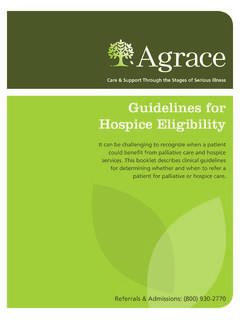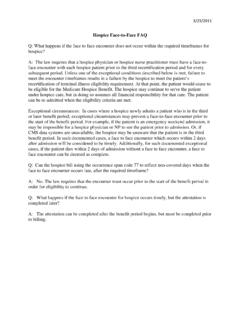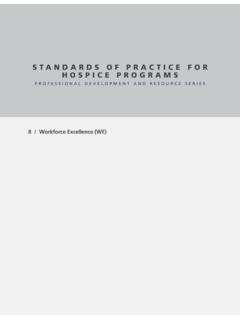Transcription of Hospice Toolkit: An Overview of the Medicaid Hospice Benefit
1 An Overview of the Medicaid Hospice Benefit2 Content SummaryThis booklet discusses the purpose of the Medicaid Hospice program, the difference between Hospice care and palliative care, the participant s right to choose to participate in Hospice care, and the Hospice certification and enrollment process. Through a series of questions, the booklet will help Medicaid participants, their family members, and other persons assigned to help guide their care understand the Medicaid Hospice Benefit and changes in Hospice provider requirements to improve communication and quality of care for Hospice patients. In addition, this booklet explains the process to report concerns related to Hospice Overview of the Medicaid Hospice BenefitIntroductionThe Centers for Medicare & Medicaid Services (CMS) and the States are helping Medicaid participants understand their roles in ensuring they receive the care that they need and how to report matters of concern they may have related to the Medicaid Hospice care is designed to provide comfort and support to terminally ill patients during their final months of life.
2 It is a time when there are hard choices to make. Talking about end-of-life care may be hard. Choosing Hospice instead of treating medical condition(s) may be hard. In this booklet, you includes you the participant and your family members or other persons you assign to help guide your you qualify for Hospice care, you and your loved ones need accurate information to make good decisions. If you are asked to enroll in Hospice when you are not eligible, are offered services you do not yet need, or receive care you believe is not part of the Hospice Benefit , contact your State Medicaid agency (SMA) or Medicaid Fraud Control Unit (MFCU). You can find a link to the current list of contacts to report potential fraud at on the CMS is best to learn about Hospice care and understand what Medicaid covers in the early stages of an illness. This helps make the decision to choose Hospice easier if you become terminally booklet will help you, your family members, and other persons assigned to help guide your care follow the Medicaid rules and answer the following questions: What is Hospice care?
3 Who is eligible for Hospice ? Where is Hospice care received? What does the Medicaid Hospice program cover? Are you receiving quality care? What can you do to help? Where should you report concerns related to Hospice care?By knowing the answers to these questions, you can get the services you need, and you can help Medicaid continue to provide services to others who need Is Hospice Care? Medicaid participants can receive Hospice care when they are terminally ill. Terminally ill means the patient has been diagnosed with a medical condition that reduces their life expectancy and is near the end of life. Each State can decide the length of the life expectancy a patient must have to receive Hospice care under Medicaid . Some States, including Kentucky[1] and Texas,[2] use the Medicare definition of terminally ill as a medical prognosis with a life expectancy of 6 months or less if the illness runs its normal course.
4 [3] Other States, like New York, define terminally ill as a medical prognosis with a life expectancy of 12 months or less for Hospice eligibility .[4] Your State may allow the election of the Hospice Benefit sooner. Check with your SMA if you have care can help manage the pain and symptoms of illness, whether the illness is terminal or not. Palliative care is different than curative care, which seeks to cure a disease or medical condition. Hospice focuses on comforting the patient rather than curing the terminal illness. If you choose Hospice care, it is important that you understand your prognosis, the Hospice Benefit , and eligibility criteria for Hospice Hospice Benefit does not include treatment to cure a terminal illness[5] unless you are younger than 21 years of age.[6]The goal of Hospice care is to: Improve quality of life; and Help manage a terminal illness and related conditions.
5 [7] Hospice agencies provide palliative care to the terminally ill as a part of the Hospice Benefit . Hospice agencies may also provide palliative care alongside treatment as a separate service to persons who have a serious or life-threatening illness but are not at the end of life.[8] Medicaid participants may receive palliative care before they are eligible for the Hospice Benefit and while getting treatment for the cure of an illness. If conditions worsen, and the individual meets the State Medicaid requirements for Hospice , he or she may choose to receive Hospice care.[9] If you have questions, talk to your physician about the type of care you want, ask the Hospice provider about the type of care you are getting, and check with your SMA about what services are Is Eligible for Hospice ?To be eligible for Hospice care under Medicaid : You must be terminally ill as certified by a physician; You must choose the Hospice Benefit by completing and signing an election form; You must agree to receive care to manage your symptoms and make you comfortable, but give up care to cure your illness, unless you are younger than age 21; and Your physician must state that you have a reduced life expectancy as defined by your State each time he or she certifies your eligibility .
6 Your physician will know the State Medicaid requirements.[10, 11]5An Overview of the Medicaid Hospice BenefitMedicaid will pay for your Hospice care after you complete and sign the election of Hospice benefits form. If you are too ill, a legal representative of your choice may complete and sign the form for you.[12] Your election remains in effect as long as you receive Hospice care. It is also in effect as long as you do not choose to leave Hospice , you are not discharged from Hospice for limited reasons, and you cooperate with care.[13]States are required to offer Hospice benefits for at least 210 days (approximately 7 months). States may divide these days into three time periods, usually two 90-day time periods and one 30-day time period.[14] Although States are not required to adopt Medicare guidelines for time periods, many including Kentucky[15] and Washington[16] do to coordinate care.
7 Check with your SMA to see whether time periods are different in your the end of each time period, your eligibility for Hospice care must be recertified. Your provider may also ask you to sign additional SMA forms for recertification. You can change the agency that provides the Hospice care at this you are expected to reach the third period of care, and you are eligible for both Medicaid and Medicare, the Hospice physician is required to meet you in person (this is called a face-to-face visit). The visit is to determine whether you are still eligible for Medicare Hospice care.[17] There have been times when patients needed nursing home care or extensive physical care instead of Hospice care.[18] Talk to your physician to see if you are eligible for Hospice Is Hospice Care Received? Hospice care is usually provided in your home. If you live in a facility, such as a nursing home, Medicaid considers the facility to be your home.
8 [19] There are also other locations, such as assisted living facilities, rehabilitation centers, or hospitals, where Hospice services can be covered.[20] Check with your SMA for other facilities that may be considered your home under the Medicaid Hospice June 2013, Medicare and Medicaid set new rules about coordination between Hospice and long-term care facilities.[21] The reason for the change in the rules is to: Improve the quality of care you receive; and Improve the communication between nursing homes and Hospice among your various health care providers is important. Communication is also necessary so you, your providers, and your family members can stay informed. If you live in a nursing home or other facility and you are not sure about something, you should ask Does the Medicaid Hospice Program Cover? Hospice services are covered as part of your Medicaid benefits.
9 [22] Services are provided by a team to meet your needs. The Hospice team may include you, your family, and others who can help meet your physical, psychosocial, spiritual, and emotional needs. Your needs are written in a plan of care (POC), also called a plan.[23]The benefits listed below are examples of Hospice services you may receive: Physician services provided by the Hospice agency; Nursing care;6 Medical equipment; Medical supplies; Drugs for symptom control and pain relief; Hospice aide and homemaker services; Physical therapy; Occupational therapy; Speech-language pathology services; Social worker services; Dietary counseling; and Short-term inpatient care for pain control, symptom management, and respite care.[24] Hospice benefits may also include anything needed to manage your terminal illness and related conditions that is normally covered by Medicaid .
10 The following Hospice services must be provided directly by Hospice employees: Nursing care; Physician services; Medical social services; and Hospice services may be provided, such as visits by a physician who specializes in your illness.[25] Hospice benefits may be different in each State. Check with your SMA about Hospice benefits in the Overview of the Medicaid Hospice BenefitAre You Receiving Quality Care?If you are receiving Hospice services, you have a right to quality care.[26] Some examples of quality care are: Care is focused on you and your family; Information is provided to you and your family so you can make decisions; Staff members respect decisions made by you and your family; Care addresses your total needs; You are not denied access to care because of your race, gender, religion, or sexual orientation; Staff members are trained in how to care for you and your family; and Care is coordinated between your medical team and Hospice agency.













